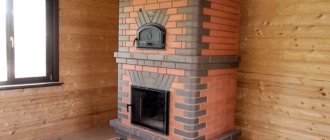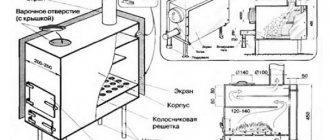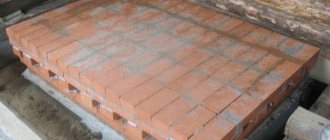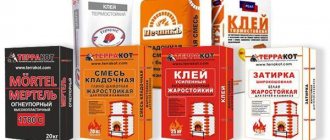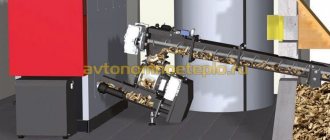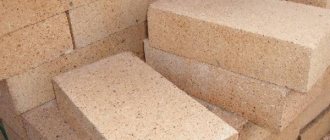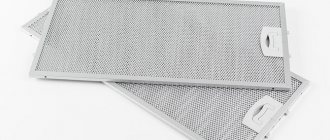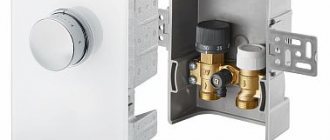Pros and cons of the oven
A conventional stove distributes heat unevenly: it is very hot right next to the stove, and the further you go, the colder it becomes. The presence of a water circuit allows the heat produced by the stove to be evenly distributed throughout the house.
Construction of a heating furnace with a water circuit
Thus, only one stove can heat several rooms in the house at the same time. The stove works almost the same as a solid fuel boiler. Only it doesn’t just heat up the coolant and water circuit. In addition, the walls and smoke channels are heated, which also play an important role in the heating process.
The heat exchanger (coil) is the main element of the stove. It is installed in the fuel part of the stove, and there the entire water heating system is connected to it.
The advantages of a furnace with a water circuit include the following features:
- First of all, for such a furnace there is no need to purchase expensive units and components.
- A properly built stove will serve you for a long time without requiring expensive repairs. Sometimes, you may only need a small cosmetic one.
- The stove can be created in any design: shape, size, decoration - all this is according to your taste and financial capabilities.
- If you compare a stove equipped with a water circuit and a solid fuel boiler, then with the help of the first one heats not only the coolant, but also the smoke outlets.
- The coil can be equipped with an already built stove. It can also be inserted into a cooking stove.
A stove option that fits perfectly into the interior of the room.
This type of heating also has disadvantages.
- When the heat exchanger is inserted into the fuel part, the latter's precious space is greatly reduced. The problem can be solved if the heat exchanger is built into the furnace during its construction. This part just needs to be increased. Well, if it is inserted into an already built structure, then there is no other way out except to add fuel incompletely, but in parts.
- With such a stove, the fire hazard increases. There is an open fire burning in the stove and fireplace, plus spare wood is often stored nearby. Do not leave this unit unattended.
- If the stove is operated incorrectly, carbon monoxide entering the home can lead to very dire consequences.
An image from which it becomes clear that it is better not to leave the unit unattended.
Experts advise using non-freezing liquid in such structures if people do not live in the house permanently, but, for example, only in the summer.
Self-construction
Independent work without the involvement of specialists brings not only saving money, but also the indescribable pleasure of your own victory. Every craftsman will not miss the opportunity to install a water circuit for a fireplace with his own hands. To do this, all work must be divided into two parts: the construction of the building, the role of which is played by a brick fireplace, and the installation of a heat exchanger.
Construction of the building
The construction of any facility requires thorough preparation. First you need to find the necessary drawings showing the orderly laying of the fireplace. It is important to select only those materials that will allow you to build a fireplace with a water jacket in the form of separate channels. The walls of the jacket are framed with steel sheets for tightness.
Construction begins from the foundation. To do this, dig a pit, the area of which is slightly larger than the area of the future fireplace. To fill the foundation you will need the following material:
- crushed stone;
- sand;
- boards for formwork;
- cement;
- roofing felt
Initial stages of construction
The foundation level must be raised to the floor level. Before laying the fireplace, the surface is lined with sheets of roofing material for waterproofing. The fireplace body is lined with refractory bricks, and the firebox itself is lined with heat-resistant fireclay bricks. A clay mixture is used as a solution.
Preparing the solution is a long task. You will have to first test the clay for fat content, and then soak it to prepare a fine mixture of clay and sand. Today you can purchase already prepared and dosed mixtures, which just need to be diluted according to the instructions and they will be suitable for laying fireplaces. Due to the wide variety of mixtures, carefully read the instructions, which describe the scope of application.
The laying of the fireplace begins with horizontal rows that serve as the base. This is standard procedure for all models. At this stage, it is important to respect the horizon of the constructed foundation. Then the formation of the ash pan begins, as a mandatory part for all solid fuel fireplaces. The beginning of the construction of the firebox is also similar to most projects, but the finalization of this stage is distinctive. The fact is that you need to install the heat exchanger right now, otherwise there will be no such opportunity.
Good to know: Designs of brick stoves and fireplaces, how to calculate it yourself, where to get a ready-made solution
Heat exchanger
The simplest model of a heat exchanger is a small tank with two flanges to which pipes will be connected. One pipe will supply cold water, and the other will drain hot water. Flame has a destructive effect on metal. In addition to temperature differences, one should not forget about the chemical effect of combustion products. The material for the heat exchanger can be metal, about 4 mm thick. A smaller thickness will significantly reduce the life of the container.
Construction of a fireplace
More precise dimensions of the heat exchanger depend on the specific design of the fireplace. According to the established dimensions, the sheet of iron is cut. You must know how to use welding to construct the tank.
If you have enough experience in welding, then immediately think about increasing the efficiency of the device by making it from sections, registers, in the form of a labyrinth or a coil. The labyrinth is made from pieces of metal pipes and turning angles of the same diameter.
How to make it yourself
If you intend to independently equip your country house with a stove - a fireplace with a water circuit, then carefully evaluate your capabilities and abilities.
There are quite a lot of ready-made devices of this type that can be purchased assembled, installed in a convenient place, connected to a chimney and connected to a water heating system. To install such a structure, it is necessary to prepare a special foundation: a foundation and a tiled area near the fireplace area. The latter is especially necessary if the floor in the house is wooden, since small coals falling from the fireplace insert can cause a fire.
Typically, such ovens have a transparent door made of heat-resistant glass, through which you can admire the burning flames. If necessary, such a device can be relocated to a new location without losing its performance qualities.
You can also build your own outdoor fireplace with a brick water circuit that will last you a lifetime.
First, you need to decide on the size of the fireplace and its permanent location, because it will be impossible to move a brick fireplace with a heat exchanger to a new location. The size of the fireplace should be commensurate with the height of the ceilings and the surrounding interior. There should be enough space around the fireplace to accommodate all guests in the house.
If you are an experienced builder, you don't need to limit yourself in design choices.
The main elements of an open fireplace with a water circuit:
- A solid foundation, which is poured from concrete mortar or laid out of brick;
- Firebox with water heating circuit;
- A portal with a recess for the firebox (which is then covered with stone or tile cladding);
- Chimney;
- Portal lining elements;
- Heating connection system.
Most designs use brick, which is the most economical material for creating both the foundation and skeleton of the fireplace.
The firebox for the fireplace is selected based on its approximate performance and based on the size of the room. It is advisable to purchase a more powerful device, with a margin of approximately 25-30% of the required consumption.
The design of the firebox and its type are important. There are corner and built-in fireboxes - inserts, but they all require proper installation and subsequent cladding.
All fireplace inserts with a water circuit provide heating not only of the coolant, but also of the surrounding space. This fact must be taken into account during installation and a portal must be built under the fireplace stove in strict accordance with the drawings specified in the documentation.
When creating a brick portal, it is necessary to use refractory ceramic bricks. Another option is to use foam blocks, which are laid on fire-resistant glue and strengthened with reinforcement.
The installation of the chimney must comply with fire safety standards, for which it is necessary to invite a specialist and obtain the necessary permits from the fire inspection service.
To give the fireplace an attractive appearance and create a romantic atmosphere, the surface of the portal is lined with natural or artificial stone, tiles or tiles.
You need to connect a homemade fireplace with a built-in water circuit very competently, since the efficiency of its operation will largely depend on this.
Important conditions due to which the water circuit will be protected from overheating:
- Creating a so-called “safety group” when connecting, which is necessary so that in the event of an emergency increase in pressure in the system, it can be urgently lowered;
- Installation of a “mixing unit” with an adjustment valve to redirect part of the hot water to another circuit, for example, to a “warm floor” system;
- Installation of expansion tank. In the case when a closed heating system is installed, a membrane tank is installed to prevent oxygen from entering the pipes. For open heating systems, an option is provided in the form of a container built into the highest point of the system;
- The use of metal pipes when connecting elements of the heating system. Since heating water can reach its boiling point, pipes made of metal-plastic or PVC may become unusable. The best choice is metal pipes. Copper pipes are an excellent choice, as they are durable and do not develop internal deposits (rust). However, in this case, it is necessary to use brass adapters and copper radiators, since it is unacceptable to mix copper and aluminum products when installing one system, as this can cause an accident.
Source of thermal energy for the system
The part of the system that provides the transport function is not of interest to us. The theory of its functioning is needed in order to make heating with your own hands. As a source that would heat the water, you can use a gas boiler or an electric one.
Good to know: What types of fireplace inserts are there and how they differ
The fireplace as a water heater turns into a multifunctional device. He continues his mission to provide the external decoration of the room and create comfort from the opportunity to contemplate the combustion process, but to warm up all the rooms, they use a fireplace with water heating.
The rather low efficiency index, especially for a fireplace with an open firebox, does not allow us to hope for high-quality heating during periods of severe frost. But for a small house this option is quite suitable. If you provide the ability to connect and disconnect the fireplace from the heating system, then the ideal option can be realized.
Commissioned furnace
The idea is that the main heating is taken over by the device that is intended for this purpose. At the right moment, the fireplace turns on and provides additional energy. At dachas, when the owners leave for a while, the fireplace can be turned off and the main boiler left running.
How does a ground heat exchanger work?
The temperature of the earth at a depth of 2 m is always within about +10 °C. This value is inherent for any region of the CIS. Using a ground heat exchanger, you can take this energy and use it to cool the air in the summer, while saving on the operation of the air conditioner, and in the winter, warm it up and save the heat generated by the heating equipment. Using an air heat exchanger, the air can be heated and cooled by 5 °C or 20 °C.
The indicator is determined by the difference in air and soil temperatures. This suggests that such a design cannot be used throughout the year. For example, in summer, using a heat exchanger, it will be possible to reduce the temperature from +30 °C to +20 °C, and in winter, raise it from -20 °C to 0 °C. However, it is better not to use a heat exchanger in spring and autumn. So, if the room temperature was about +12 °C, then with the device in question it will drop to +8 °C.
Therefore, when starting to assemble the heat exchanger, it is necessary to provide for the possibility of turning it off.
Selection of materials and available tools for the coil
If you want to buy a furnace coil or make it yourself, the first thing you need to pay attention to is the materials from which it will be made:
| Photo of the coil | Material selection | Description of materials |
| Copper | A high-quality pipe made of such material should have an optimal indicator and thermal conductivity coefficient, which ideally will be about 380. | |
| Steel | Steel variations have an average cost. This variety must also have a certain thermal conductivity coefficient. For such a metal it will be 50. | |
| Metal-plastic | The simplest option, the coefficient of thermal conductivity of which is minimal, only 0.3, is metal-plastic. |
The basis of any coil is a pipe, which is made of one of the materials described above. The thermal conductivity and efficiency of such a design depends on the diameter and length of such a system.
With the same transverse size, at the same level of heat transfer, the length of metal-plastic and copper pipes will be different. In the first case, the length will be 11. If we talk about the steel variation, then the length with the same characteristics will be 5-8 times greater in comparison with copper ones.
The best option and material from which the coil will be made will be a fired copper pipe. The advantages of this material include the high strength and durability of the product, while you can easily give the material the desired shape, as well as attach a fitting using a thread.
Since the cost of finished copper fittings and pipes is quite high, in order to save money, you can look for devices made from this material that you no longer use, but the material has fully retained all its characteristics. Alternatively, you can use:
- Heating radiators that have not previously leaked;
- Heated towel rails;
- Car radiators and other structures similar in structure and appearance;
- Ceiling type water heaters.
Now, you need to take a closer look and review the main design features of such products:
- The device must not come into direct contact with a burning flame.
- The main element is a tank with a certain capacity, from which connecting pipes emerge;
- In another room, the pipes should lead to a second tank, the capacity of which will be slightly larger than that of the first. Thus, heated water will be able to circulate fully and safely throughout the media;
- Heat exchangers can also differ in type; they can be external or internal;
- The internal heat exchanger is more difficult to install than the external one, however, the external one, in turn, is easier to maintain;
- The internal heat exchange element is mounted directly into the structure of the furnace itself and is located above the combustion chamber. It is installed at the construction stage of the brick stove or mounted in the portal, if you have chosen a ready-made steel or cast iron fireplace insert.
The furnace coil must be quite efficient, which is why, during the design process, it is necessary to ensure that the total surface area of the structure is very large.
Also, to make a heat exchanger, you can use smooth-walled pipes that have a diameter of about 4-5 centimeters. If we look at them, we can note that in their shape they resemble a large letter G.
The return line and the outlet from which hot water comes out can be placed with equal success on either side. You can also give preference to installing a rectangular or cylindrical tank indoors. The coil in these cases is located directly inside the structure; the length of this variation depends on the heating unit itself, its dimensions and power.
Also, the heat exchange element can be installed directly on the chimney hood. In this case, it will have a characteristic cylindrical shape, the pipes are placed in the lower part, and from above it goes into a chimney, which has a similar diameter and shape. This variation is ideal for both generating heat used to warm up rooms and for heating hot water.
However, if you decide to install a heat exchanger on the chimney, you must remember that due to the rapid cooling of the combustion alleys, the draft in the hood may be disrupted and become insufficient for the effective removal of waste products of combustion and decay.
The coil can also be placed next to the stove, which not only performs a heating function, but is also used for cooking. In this case, it is important that the heated gas moves above the top shelf and is discharged through the chimney. Thus, the oven with the hob will be located above the heat exchange medium. If necessary, you don’t have to install the top shelf; in this case, the bottom and side parts will be connected to each other using pipes.
Do-it-yourself water-water heat exchanger saves on heating
A heat exchanger is a device designed for the exchange of energy between media that do not have their own source of energy supply. For example, a fireplace in a house will not be a heat exchanger, but batteries are a clear representative of them. These devices are widely used in everyday life. They can heat a home, heat water, ventilate and condition indoor air. Therefore, everyone who likes to independently arrange a comfortable home is interested in how and where you can make a heat exchanger with your own hands and what is needed for this.
Types of heat exchangers
It will be difficult for a person inexperienced in engineering, and even without welding skills, to understand the professional systematization of heat exchangers, so let’s analyze their simpler classification.
- Water-water. Perhaps you can create a personalized water heat exchanger with your own hands, not in an industrial environment. This device consists of two sectors, one of which heats the other. In a heating tank with high power, water circulates through a fairly short and closed circuit, the temperature of which is up to 180°C. It flows around installed tubes filled with central coolant and increases the temperature of the water in the main system.
How to make a water-to-water heat exchanger from a copper tube?
- Capacity. It's essentially a steel tank. The shape of the tank is not particularly important for the efficiency of the device. It should be installed near the beginning of the heating system. It should have two tubular branches for water circulation. The entrance for cold is located at the bottom, and the entrance for hot is at the top. Of course, the tank must be sealed.
- Copper tube. Spiral blocks of copper tube are placed inside the tank. Why is copper tube used? The answer is simple - copper has the best thermal conductivity. For a hundred-liter tank, 4 meters of such pipe is enough.
Power regulator. There are power regulators with a heating element. These are the ones you should use when making a heat exchanger with your own hands for heating a room. The regulator is connected to a copper tube.
Anode. Temperature changes and possible pressure changes destroy the container. To protect it, an anode is most often installed near the heating element. After the above parts of the copper tube heat exchanger are securely installed, the tank is hermetically sealed and filled with water. The system can be checked.
Electric heated towel rail: how to choose the right one
After finishing a bathroom renovation, any owner thinks about how to fully equip it. Plumbing, furniture, washing machine –…
Criteria for choosing a gas boiler for your home
More modern double-circuit heating devices have now become quite popular for heating a home. They can be purchased…
Silencers for ventilation
There are no absolutely silent ventilation systems. It is impossible to completely get rid of noise, but reduce it to the level where it...
Installation and piping of a heating boiler
The main element of the heating system is the boiler. Installation of boilers involves the use of polypropylene or metal pipes. Modern polypropylene pipes, with the help of which…
How to choose an air compressor
Air compressors are now used in almost all manufacturing and industrial companies. It is impossible to imagine any enterprise without them.…
Possibility of use
It’s good when a suburban area is gasified. The choice of heating is clear. Due to rising energy prices, for many the problem of finding alternative heating becomes urgent. The situation is not critical if you use fireplace stoves for heating. They are used in steam, water or air heating. The power of the device and the selected system will determine the degree of integration of the water heating device.
As the main source of heating
Classic fireplaces and stoves are good for small houses and cottages. What should owners of townhouses and cottages expect? Solid fuel fireplaces with a water circuit will come to the rescue.
The water heating system is the most popular because of its functional simplicity, practicality and availability of materials. In addition, it can be completely autonomous when installed with natural coolant circulation. By connecting a fireplace with a heating circuit to a water system, uniform heating of a residential building is ensured.
The option of using a water fireplace as the main water heating device in the heating system requires certain conditions:
- Daily work - maintaining a fire requires permanent residence in the house.
- The ratio of power and area (volume) of premises. The larger the area, the more powerful the heating unit is required to operate. The condition is 1 kW per 25 cubic meters. m of premises.
- Household needs. In addition to heating, you need to get hot water and cook food.
- Type of fuel – for more efficient use it is possible to use coal or pellets.
- Selection of equipment (furnace), wiring, connection diagram. Since the water heating system has various design options - open or closed; single-circuit, double-circuit or three-pipe, equipment is selected according to the selected scheme.
The heating system is designed individually for each home based on its characteristics.
Supporting role
Many people recommend using a fireplace with a water heating circuit as a backup heating device. Integrated into an existing heating system, it will perform several tasks:
- saving energy resources;
- preservation of decorative function;
- increasing the efficiency of the heating system;
- maintaining a microclimate - does not dry out the air.
Merger options may be different: the main sources are gas or electric heat generators, solid fuel boilers. In this case, the operation of the main unit can be interrupted automatically or manually when an additional one is connected. Although they can work at the same time, say, in very cold weather. A successful combination is to operate a fireplace during the day and an electric or gas boiler at night.
Design features
Most often, a metal tank with a capacity of up to 5 liters with built-in pipes acts as a heat exchanger. There is no direct contact with fire. The device allows you to heat cold water, which then flows into radiators or a removable tank of larger capacity located in the same or an adjacent room.
As a result, by heating the stove in one room, it will be possible to heat another. According to its design, the heat exchanger for a furnace can be external or internal.
This type is very similar to a tank filled with coolant. Inside the container there is a part of the pipe used to remove combustion products. In terms of its design, the external heat exchanger is more complex than the internal one, as it places increased demands on welding work.
However, its maintenance is much easier. If necessary, the tank can be dismantled to remove scale or eliminate leaks.
Interior
Mounted above the firebox directly inside the stove. It is easy to install, but if maintenance is necessary, certain difficulties may arise. Especially if the stove is made of brick.
To avoid this, at the time of design development it is worth taking care of the maintainability of the future heat exchanger.
How the system works
To heat a house, it is allowed to use a home-made device, which is characterized by simplicity of design. It operates in such a way that the energy from coal processing is supplied to it from the furnace. The water is heated and distributed through pipes to all rooms. The heat is distributed evenly, which ensures a comfortable atmosphere throughout the entire home. At the same time, the cost of purchasing fuel is reduced. Stove heating can be improved by resorting to two methods:
- equip the furnace from scratch, adapting to the existing dimensions of the heat exchanger;
- equip a homemade heat exchanger and integrate it into a stove that is already available.
A finished stove, created in accordance with all requirements, will work no worse than a fuel boiler. It will be equipped with a water circuit. The only difference here concerns the location of the heat exchanger inlet. It will be located slightly higher above the floor than in factory devices. This is a fairly noticeable difference that can affect the natural circulation time of the carrier.
During installation, the cold water pipe, also called the return pipe, should be located as low as possible. An expansion tank must be installed at the top point of the pipes. It will provide compensation for the volume of heated liquid if it changes, releasing air bubbles from the system. If heating with natural circulation is not enough to service a large cottage, additional installation of a circulation pump will be required.
Do-it-yourself pipe coil, classification, manufacturing option
Each heating system includes the main component - a pipe coil. It creates the role of heat transfer from the generator to the heat carrier.
The wide selection of heating equipment on the market does not reduce the desire of business owners to invent their own models, improved and structurally conventional.
Specifications and working principle
The medium in the heat exchanger can be of a wide variety of types:
The simplest system is considered to be a room heating device saturated with water. The heat transfer is also influenced by the material used to manufacture the device. The best effect according to physical indicators is provided by copper and silver. Steel and plastic products are 6-8 times inferior to copper ones. Therefore, before selecting a material, it is necessary to take into account the effectiveness of operation.
The working principle of a pipe coil is to move water in a closed loop through the coil and distribute it throughout the entire circuit, including heating devices. The liquid returns through the return pipe in cooled form.
The structure is located in the radiator chamber, so when making it yourself you need to take its dimensions into account
Classification of heat exchangers
• The designs differ in the following types:
— surface ones function due to the intermediate contact of two media, due to which the heat carrier is heated;
— regenerative include the supply of hot and cold water to obtain the required temperature regime by heating or cooling it;
— mixing machines perform work by mixing two media of different temperatures.
• According to their intended purpose, heat exchangers are:
— heating (heated gas or liquid moves along the circuit);
— cooling (the working principle is based on the contact of liquid and cold gas).
• The shape of the structure usually has different shapes:
- in the form of thin tubes twisted in a spiral (towel rail);
— plate modules with liquid passing through them;
- a pipe built into a pipe.
How to make a pipe coil yourself
You can make a heating equipment component with your own hands. To do this you need a minimum of materials:
— steel tank (wall thickness 2.5-3 mm);
— 2 T-shaped tees.
1. The tank is installed at a distance from the stove of at least 2.5-3 meters. The tank must be raised 1 meter from the floor.
2. Make 2 holes in the tank: at the top for hot water outlet, at the bottom for cold liquid supply.
3. Give the pipe a spiral shape to create a heated towel rail.
4. Install the pipe into the tank, leading the ends through the holes made.
5. Secure threaded fittings to the ends.
6. Make the holes with the outlet pipe sealed.
7. Install a power regulator on the pipe. You can do without it, but such a device will make it possible to practically spend energy.
8. Fix the terminals and wires for power supply to the external water thermostat.
9. To eliminate the expansion of the tank during heating, it is necessary to install an anode.
10. Check that all connections are tight.
11. Fill the tank with water.
The pipe coil, made with your own hands, is ready.
Manufacturing recommendations
You can make a heat exchanger with your own hands for the furnace, having a different shape. Plate products can be used, as well as a register consisting of several pipes. They are made of copper or steel. In the combustion zone, especially when it comes to coal, there is a high temperature. That is why impressive requirements are placed on the metal of which the heat exchanger is composed.
A water heat exchanger must transfer heat, which is why the thermal conductivity of the metal is of great importance. For example, a copper pipe transmits heat 7 times more than one made of steel. That is why, having the same diameter to transfer the same amount of heat, you will need 3.5 m of copper pipe, while a steel pipe will have to take 25 m. Copper is economical to work with, but is expensive. You can make heat exchangers from steel yourself if their diameter is at least 32 mm.
If the owner of the house intends to use coal for heating, it is better to make a heat exchanger for the stove from cast iron. Such material will better withstand fire. In addition, it is the strongest.
How to choose the right one
When choosing, the price of the heat exchanger for the furnace plays a fundamental role. The design decision depends on the choice of material
The second most important aspect is manufacturing capability.
And the final choice is the place where the stove will stand. You need to take into account what exactly you want to achieve. You need a heating and cooking stove or garage heating, whether it be a heater for a bathhouse or a stove for heating a country house. Each option has its own characteristics and subtleties.
The main thing is to accurately calculate what area needs to be heated, whether hot water is needed, how many units of fuel can be spent during the heating season, and much more. The result of all estimates should be the same, focusing on finances, available materials, needs, and choosing the most suitable design.
What is better in different options:
What types of homemade furnace heat exchangers can there be?
In addition to the structural differences in furnace boilers discussed above, which depend on the selected material for their manufacture, their designs may also differ depending on the type of furnace. for which they are actually intended. Such stoves can be heating or heating-cooking.
The design of the heat exchanger for a heating and cooking stove is different in that in its upper part there is an open space for the flame to access the cooking stove. In registers for heating stoves, the upper part, as a rule, is covered with a solid sheet or rows of pipes.
The shape and dimensions of stove boilers are selected in accordance with the size and shape of the place where they are supposed to be installed (most often this is the firebox of the stove), as well as depending on its required thermal power.
Boiler designs for heating furnaces with a water circuit
Here we will look at the three most common designs, made separately from sheet metal and pipes, as well as their combinations.
The heat exchanger is a solid U-shaped structure, welded from sheet metal, intended for placement in the firebox of a heating furnace. The heat transfer surface is its internal walls.
Sheet metal heat exchanger for heating furnace
Furnace boiler made of pipes. Cold water from the system is supplied through the “return” to the lower U-shaped pipe of the base of the heat exchanger (with a diameter of 40-50 mm and a wall thickness of 3-4 mm), gradually heating up, it flows through L-shaped vertical pipes (the same cross-section as A U-shaped base or smaller) rises up and enters the upper collector pipe, and from it, already heated, into the heating system of the house. Such a register is more efficient than one made of sheet steel, but also more difficult to manufacture, since you will have to make many pipe joints and weld them.
Furnace register for heating stove made of pipes
The side surfaces of this register are made of sheet metal 3-5 mm thick and are solid panels 40-45 mm thick, and the upper part is connected to each other by a number of horizontal pipes with a diameter of 40-50 mm.
The use of pipes instead of a solid surface (as in option 1) allows you to increase the area of contact with the heating medium, and the use of sheet metal for the side panels simplifies the manufacturing process, which is important if you decide to make it yourself. Furnace boiler made of sheet metal and pipes for a heating furnace. Furnace boiler made of sheet metal and pipes for heating furnace
Furnace boiler made of sheet metal and pipes for heating furnace
Furnace boilers (registers) for heating and cooking furnaces
Heat exchangers for heating and cooking furnaces can also be made from both sheet iron and pipes (round or profile), as well as by combining them. Let's consider several options.
Heat exchanger for a heating and cooking stove or stove in the form of two solid side panels made of sheet metal (“book”) connected to each other.
Heat exchanger for heating and cooking furnace
A furnace boiler made of round and rectangular pipes: round ones (40-50x4 mm in diameter) are arranged horizontally and connected into a structure using rectangular ones 50-60x40x4 mm. This combination of different types of pipes facilitates the manufacture of the boiler. Dimensions a, b, c and d are calculated depending on the size of the firebox and the required register power.
Heat exchanger for heating and cooking furnace made of round and profile pipes
Heat exchange register made only of round pipes. It consists of two horizontal circuits connected by vertical pipes. Cold water from the system is supplied to the lower circuit, and heated water from the upper circuit is supplied back to the heating system.
Register for a heating and cooking furnace made of pipes
What can a furnace heat exchanger be made from?
In order to make a heat exchanger for a furnace with your own hands, you can use sheet “black” steel with a thickness of 3-5 mm or steel pipes (round or profile) with the same wall thickness and a diameter of 30-50 mm. Alternatively, sheet or pipes made of stainless steel or copper can be used for this purpose. But, due to their high cost, these materials are used extremely rarely in the independent manufacture of furnace boilers.
It is easier to make such registers from sheet metal. They are easier to clean during use. But, as a rule, they have a smaller area of contact with the flame or hot gases, since for the most part they are solid and only their inner surface, facing the flame, participates in heat exchange. Furnace boilers made of pipes, with the same overall dimensions, as a rule, have a large heat exchange area (although this also depends on the number and diameter of pipes), since they allow flames or hot gases to come into contact with almost their entire surface. But they are more difficult to manufacture. This is especially true for structures consisting entirely of round pipes.
If pipes are used to make a heat exchanger for a furnace with a water circuit, it is best if they are seamless (solid drawn). If seam pipes are used, the seams will have to be additionally reinforced with a weld and placed on the outside of the register (from the side of the brickwork).
Very often, in the manufacture of furnace boilers, pipes and sheet iron are combined. This is done in order to use their positive qualities: to make it easier to manufacture and to have sufficient heat transfer area.
Calculation of heat exchanger area
Typically, the dimensions of the heat exchanger are calculated approximately. For example, to heat a regular-sized bathhouse, 5 kW will be enough. This is how much energy a furnace with a heat exchanger should provide to the system. The energy that one square meter of heat exchanger surface provides during combustion is 8-9 kW. True, much depends on the intensity of fuel combustion and on the location of the boiler itself in the furnace. Of course, when the combustion process is stopped, the boiler power immediately decreases, by about five to ten times. Therefore, it is necessary to calculate the surface size of the furnace heat exchanger with a multiple margin. This is the only way you will be able to create a system capable of maintaining a comfortable temperature in all rooms of the bathhouse (with a 1-time or 2-time fire).
For a bathhouse with a heat exchanger, you can choose a variety of stove boiler shapes. The boiler version made from stainless steel pipes is the most common. However, the most popular today are plate-type options and two-channel collectors.
How to make a heat exchanger for a stove with your own hands?
To make your own heat exchanger for a stove made of brick, you will need metal 2.5 mm thick. The design of the heat exchanger will be as follows: the rectangular lower container must be connected by pipes to the cylindrical upper container. An important point is to ensure minimal gaps in all mating seams. Based on the size of the bathhouse, you need to calculate the diameter of the pipes and the size of the stove itself.
After all the cut parts are ready, you need to secure them by welding. It is definitely worth checking whether the calculations were performed accurately. Then you can start assembling the heat exchanger. When it is already assembled, we check its strength. To do this, you need to weld the lower pipe and pour water into the heat exchanger. We connect the outlet hole to the container. Then you need to fill the system with compressed air, using a pressure gauge to control the pressure. If the seams are done well, they will not leak. If there are any holes in the seams, it is necessary to drain the water from the system and re-weld the problem areas. Of course, it is better that the total length of all pipes is smaller.
The need for thermal insulation depends on the purpose of the water tank, namely whether you plan to warm adjacent rooms with it or will use it only for its intended purpose.
Types of heat exchangers
When choosing a fireplace stove with a heat exchanger, please note that they can use two types of heat exchangers, in which there is a fundamental difference in the heating system:
- An open system is indirect heating of the heat exchanger. In this system, the liquid moves along a coil, which is open in the firebox. Such a system requires the presence of an open expansion tank, which in most cases is located in the attic of a country house.
In such a system, water moves according to the principle of natural gravity and circulates naturally. This system was often used during the USSR. Nowadays, they are actively being replaced by closed systems.
- A closed system where direct heating of the coolant occurs. In this option, heating is performed directly in the combustion chamber. In this case, when the liquid is heated to 90ºC, it is forcibly supplied to the heating system; for this purpose, a water pump is installed in the system. When cooling, the liquid is fed back under pressure. A membrane type water tank is used here.
The heat exchanger can have a different design. In this embodiment, they can be divided into types of manufacturing:
- An internal type heat exchanger is either a container inserted into the combustion chamber, or a coil that can be installed in any part of the combustion chamber or designed as a “jacket”, that is, it will envelop the entire combustion part.
- External heat exchanger. In this case, the chimney module is surrounded by a container, which is made hermetically sealed.
From the above we can draw a conclusion. What if you need to heat a small room where you do not live permanently. Then there is no need to install compressors with forced circulation of liquid. It just costs more and will not pay for itself soon. But if you have a large house and you live in it constantly, then you simply cannot do without forced circulation of the coolant. Therefore, you need to approach this issue wisely, and on our resource you can learn how to make water heating.
